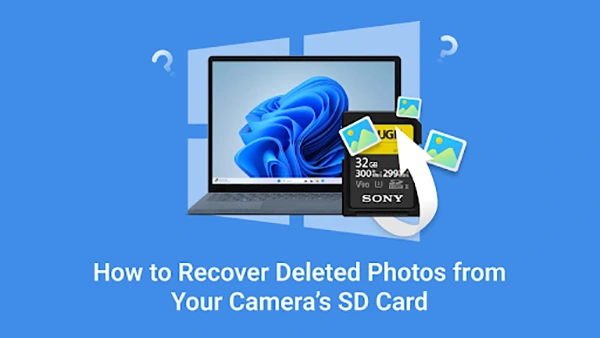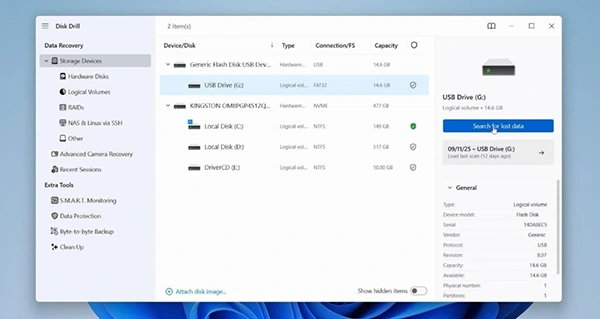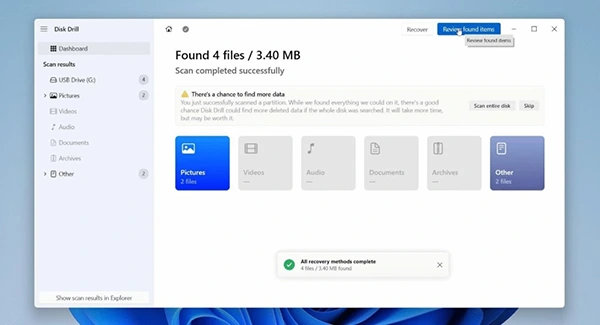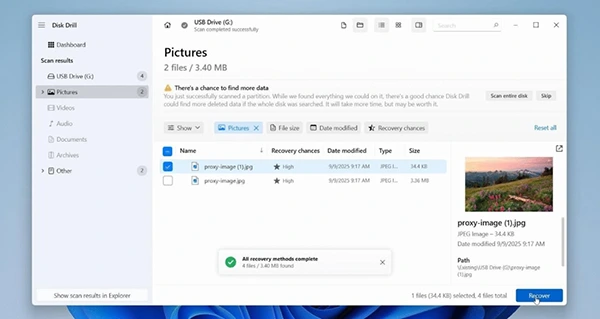Yes, but the options are limited. Your alternatives are backups and connected cloud services. If you have synchronization enabled, platforms like Canon’s cloud utilities or similar services often keep deleted files in a trash folder for a limited time. In such cases, the restoration of photos is quick and doesn’t require extra tools. That method is a great choice if you seek a way to recover recently deleted photos. Once files are gone from both the device and the cloud, however, photo recovery software becomes the only reliable option.
How to Recover Deleted Photos From Canon Camera SD Card

Accidentally deleted photos from your Canon camera? Such an instance often causes panic in us. You suddenly remember the memories, and might feel overwhelmed. It’s frustrating and heartbreaking, especially when the photos were very special to you.
But don’t worry. We have some good news for you. Photos from the Canon camera are never permanently deleted. Whether you deleted them accidentally, lost them due to an SD card error, or they got corrupted without any warning. You can get those lost photos back.
When you delete them, they do not instantly disappear. Just the space gets marked as free space. But you have to act quickly; if that space gets replaced or refilled, then you may never get those photos back.
Without wasting a second, go through this guide that shares how to recover deleted photos from a Canon camera SD card step by step with images.
Key Takeaway
- You can recover your deleted photos until the free space is not overwritten by some other photo.
- For advanced planning, always keep a backup or a copy of your photos on another drive.
- Cloud backups such as Google Photos and other Canon apps may store deleted photos for 30 days.
- In case of physical damage to the SD card, professional recovery services are the last option.
Can You Retrieve Deleted Photos from a Canon Camera?
Yes, in most cases you can recover your lost photos. But it also depends on several other factors. When you delete pictures from an SD card, the files are not wiped immediately. Instead, the system marks their space as available for new data.
Until new photos or videos overwrite that space, recovery software can usually restore deleted pictures. It’s best to take action now, before it gets too late. Once the free space is replaced by some new photo or object, it will be very hard to recover it.
How to Recover Deleted Photos from Canon Camera SD Card
For this guide, we’ll demonstrate the recovery process using Disk Drill, since it is one of the best photo recovery software available today. This is one of the most popular recovery tools for photos. Whether it’s from a professional or a common camera, it works best in all. It supports Canon’s RAW formats (CR2 and CR3), legacy CRW, as well as JPEG, HEIF, and even large video files like MP4 or MOV. This broad compatibility makes it especially valuable for photographers who work with a mix of formats.
Interesting Fact
Many of the modern Canon cameras store photos in raw formats, which makes it easy for recovery tools to restore them.
What makes users prefer it is its intuitive UI that guides users through the process without unnecessary complexity. The preview function is another strong advantage: you can view recoverable photos of any format, as long as your system has a suitable viewer installed. This allows you to confirm the quality and relevance of files before recovery, which saves both time and storage space.
Here is how to recover deleted photos from a memory card:
- Download and install Disk Drill from the official website.
- Connect your Canon SD card using a card reader.
- Launch Disk Drill and select the SD card from the device list.
- Click Search for lost data.

- Select Universal Scan.

- Once the scan completes, click Review found items or Pictures and preview your photos.

- Mark the files you want to restore and press Recover. On Windows, Disk Drill allows you to recover up to 100MB for free, which is usually enough to recover quite a few of your photos.

- Choose a safe location on a different drive to store your recovered photos.
With these steps, most Canon users can bring back lost photos quickly without any technical knowledge.
Wrapping Up
On a final note, we want to mention a couple of additional options that can sometimes save the day.
Some Canon apps and connected cloud accounts can serve as a backup lifeline. For example, Canon’s cloud storage and services like Google Drive often keep deleted files in a trash folder for up to 30 days, which makes recovery simple if you act quickly. Canon Image and Google Photos are worth checking if you have sync enabled.
As an alternative, professional data recovery services exist for cases where your SD card has physical damage or isn’t even detected by your computer. These labs use specialized equipment and may succeed where software cannot, but costs can be high. That’s why we recommend first trying DIY recovery tools; most Canon SD card issues can be handled at home without much difficulty.
Frequently Asked Questions
Is there a way to recover deleted photos from Canon cameras without software?
How to recover deleted pictures if my Canon SD card is not recognized by the computer?
Check if the SD card is present within Disk Management(PC) or Disk Utility(Mac). Try another card reader or USB port. If the card appears but is not readable, you require recovery software that will scan RAW or corrupt drives. If the SD card does not appear at all, then the issue is likely to be physical and only professional recovery will suffice.
Is photo recovery software safe to use on Canon SD cards?
Legitimate recovery software runs in read-only mode, meaning that the software reads the data from the SD card but does not change anything. So you will be perfectly safe giving it a try yourself. Be sure you only download software from legitimate sites to prevent downloading spyware. Always write your recovered photos to another data storage device, as overwriting them on the same SD card could erase other recoverable data.
How to retrieve deleted photos from internal storage?
Modern cameras rarely use internal memory, but older devices may store images directly. These cameras connect to computers using Media Transfer Protocol (MTP), which hides the file system. Without direct access, recovery software cannot scan the memory in the same way it can with an SD card. If you seek how to recover recently deleted photos from internal storage, it is far harder and often impossible without specialized tools that most users don’t have.
You don’t know how much you rely on your laptop until it acts up. The cursor stops moving. The fan…
Imagine this: You are juggling ten things—one tab for work, one for shopping, and one for that article you wanted…
The majority of engineering teams work at a much slower pace than they could because of systematic friction in their…
The dramatic evolution of eCommerce in the last decade has reshaped consumer expectations regarding speed, convenience, and sustainability. As a…
Payroll mistakes can lead to fines, delayed payments, and payroll disputes. These payroll issues can create pressure for high-risk businesses…
Property management teams can benefit from data in a number of ways. Everyone understands that it’s critical to make wise…
Fantastic things don’t just happen. They occur when teams transform hazy inputs into clear and actionable decisions for everyone, replacing…
There are lots of tasks that are generally very amusing and thrilling; however, bookkeeping is definitely not one of them.…
In the fleetly evolving geography of digital education, using slice- edge software development services are essential for creating poignant literacy…




